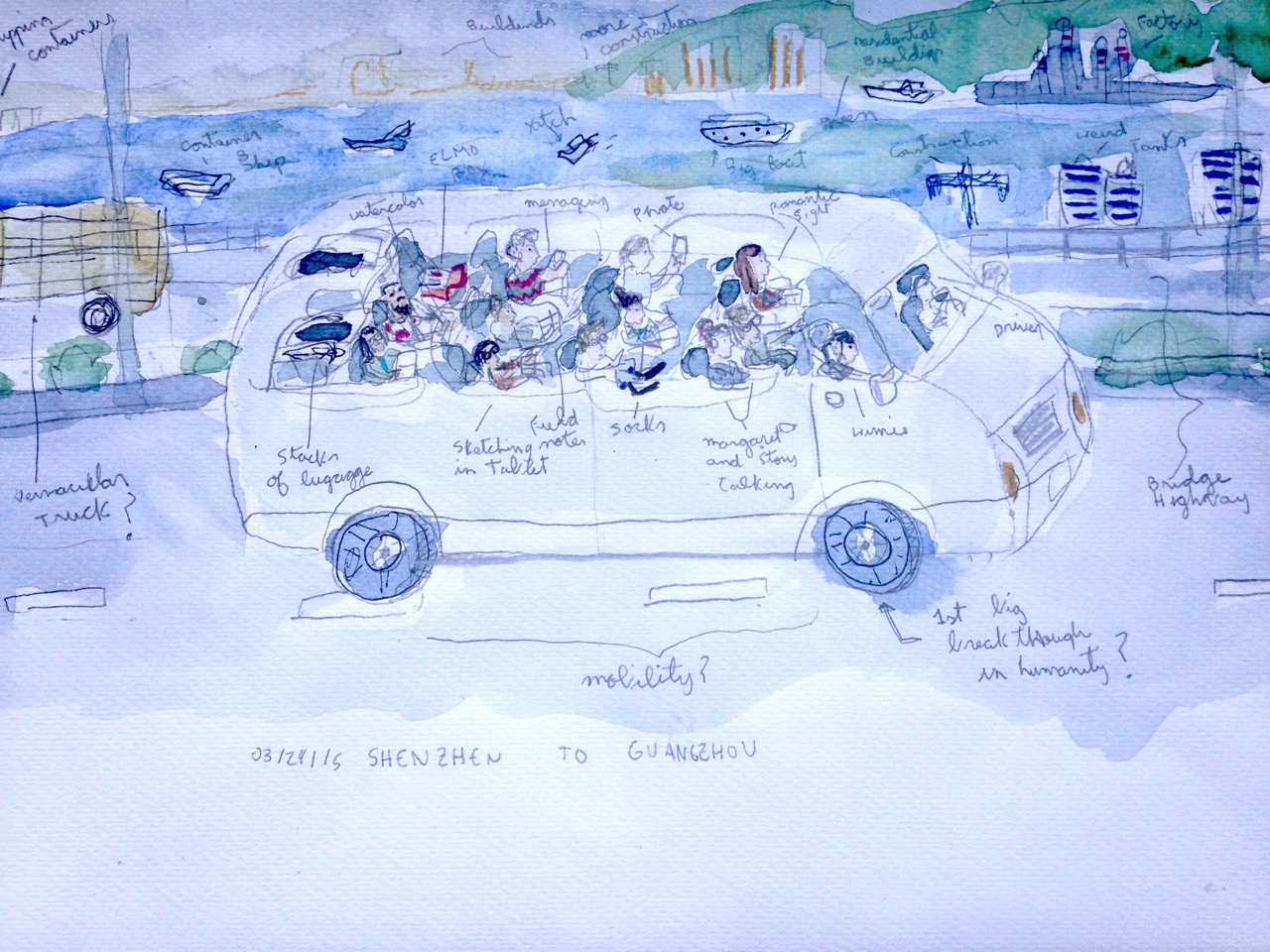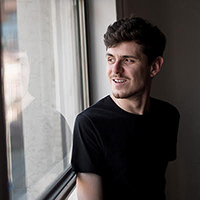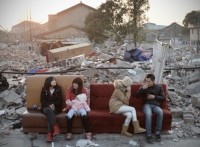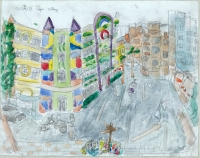GUH People: Jose Figueroa
Venezuelan-born artist currently based in Oakland, Jose Figueroa works in drawing, photography, video and sculpture. Best known for his map-like drawings that document his surroundings in playful detail, Figueroa is a keen observer of life. A self-described "impressionist," his recent travels to Paris, Cherry Grove and around San Francisco have provided much inspiration for his growing archive of queer spaces: clothing-optional beaches, clubs, among others. He studied at the Skowhegan School, Cooper Union (BFA) and received his MFA from the University of California, Berkeley. He was a graduate student in the 2015 GUH studio ART+VILLAGE+CITY in the Pearl River Delta (ARCH 209/RHETOR 205), co-taught by Margaret Crawford (Architecture) and Winnie Wong (Rhetoric).
.jpg) How did you first hear about the Global Urban Humanities Initiative and what made you want to join?
How did you first hear about the Global Urban Humanities Initiative and what made you want to join?
I first heard about the Global Urban Humanities in my first year as a master’s student of the Art Practice department. Some members of my cohort took a GUH studio course where they travelled to Los Angeles and they told me about the class exploring the Pearl River Delta next semester. I was deeply interested in the opportunity to do field practice in a foreign country and to engage in an interdisciplinary classroom. It was really insightful to connect with students from different fields with different concerns, research methodologies and intellectual products.
As a graduate student in the Art+Village+City studio, could you share your experiences participating in an interdisciplinary GUH studio?
I really value my memories of this class. I decided to document all our class meetings via watercolor paintings and I am so glad to have so many thorough maps of our classroom. There is a website with the process, experience and results of our field trip to the Pearl River Delta. Magaret Crawford and Winnie Wong were stellar mentors with whom I still keep connections with.
There are many unique memories of my 14 days in China. I remember going to an inflatable factory in industrial Guangzhou to produce an all white entryless bouncy castle. I remember going to Splendid China, the world's largest miniature park, reproducing attractions in China with my graduate advisor and Art Practice faculty Anne Walsh (who also taught the 2014 GUH studio on Los Angeles). I remember having tea with Professor Duan Qilai, the sculptor who created Lantau Island’s Big Buddha in his studio in Xiaozhou Village, and talking about objects of devotion and sites of pilgrimage. I remember also painting Dafen village’s colorful kindergarten located in the central square. Dafen oil painting village is the world's largest production center for replicas of famous oil paintings located in the city of Shenzhen. I attracted the attention of many children as well as tourists, visitors, and other painters who commented on my ability to represent the kindergarten building. This caught their eye because most painters in Dafen village paint from photographic sources and I like to paint from life.
Tell us a little bit about your current project/career and how GUH has shaped this.
After I graduated I’ve been paving a career in education and have been working with Richmond Youth. I also continued my studio practice at the Headlands Center for the Arts in Marin while pursuing other artist residencies in the US and abroad. Thanks to the Terra Foundation, I travelled to France to connect my practice to the Impressionist legacy through an immersive project with Claude Monet’s lily pond (that I am still dissecting). I recorded the iconic Golden Gate Bridge au plein air informed by photographer and geologist Mark Klett and the process of rephotography. I documented pool and beach scenes in the historical gay destination of Fire Island, NY where Oscar Wilde, Frank O’Hara and David Hockney left imprints. I would say that my time in the GUH initiative was crucial in developing elements of my ongoing observational drawing practice that responds to my surroundings as a handmade polaroid, allowing me to record more than meets the eye.

Jose Figueroa's watercolor of Art+Village+City students driving from Shenzhen to Guangzhou
Could you share one memorable moment you had as a GUH student?
I really enjoyed the time producing the exhibition highlighting the research we produced as a class. It was a pleasure to closely collaborate with Ettore Santi, Valentina Rozas-Krause and all our classmates and closely work with Winnie and Margaret. I remember we always got lunches from Babette’s.
Tell us one thing you are reading/watching/listening to that is helping you get through the quarantine.
I binge-watched Issa Rae’s Insecure and I was recently introduced to Amy Sedaris’ Strangers with Candy. I started the quarantine season with a novel called Fiebre Tropical by Juliana Lopera, Colombian writer based in the Bay Area. I’ve been revisiting The Philosophy of Andy Warhol (From A to B and Back Again) and I have a copy of Angela Y. Davis’ If They Come in the Morning on top of my side table.
GUH People: Ettore Santi
 Ettore Santi is a doctoral candidate in the Architecture department at UC Berkeley. He recently recieved a 2020 Mellon Dissertation Research Fellowship for his dissertation on "Designing a Land Revolution: The Corporate Reinvention of China's Rural Environment." Ettore received the Graduate Certificate in Global Urban Humanities in 2018 and took ARCH 209/RHETOR 250 Art+Village+City in the Pearl River Delta GUH studio course co-taught by Margaret Crawford (Architecture) and Winnie Wong (Rhetoric) in 2015, which was formative to his research development. How were you first introduced to the Global Urban Humanities Initiative and what made you want to join? Before becoming a graduate student at CED,…
Ettore Santi is a doctoral candidate in the Architecture department at UC Berkeley. He recently recieved a 2020 Mellon Dissertation Research Fellowship for his dissertation on "Designing a Land Revolution: The Corporate Reinvention of China's Rural Environment." Ettore received the Graduate Certificate in Global Urban Humanities in 2018 and took ARCH 209/RHETOR 250 Art+Village+City in the Pearl River Delta GUH studio course co-taught by Margaret Crawford (Architecture) and Winnie Wong (Rhetoric) in 2015, which was formative to his research development. How were you first introduced to the Global Urban Humanities Initiative and what made you want to join? Before becoming a graduate student at CED,…
Trace Evidence: An Art Exhibition and Panel Discussion at Minnesota Street Project
 Trace Evidence Curated by Annie Malcolm and Rachelle Reichert Exhibition September 8th – 29th Opening event + Panel: September 11, 2018 Minnesota Street Project, San Francisco Trace Evidence is an exhibition and a panel discussion at Minnesota Street Project, in partnership with SFMOMA Public Dialogue, in which the curators—2019 GUH Fellow Annie Malcolm and artist Rachelle Reichert—will convene visual artists from China and the U.S. who are considering issues of environmental change focused on China. Trace Evidence will take place in San Francisco in September 2018, during the Global Climate Action Summit, and is formally affiliated with GCAS. The curators…
Trace Evidence Curated by Annie Malcolm and Rachelle Reichert Exhibition September 8th – 29th Opening event + Panel: September 11, 2018 Minnesota Street Project, San Francisco Trace Evidence is an exhibition and a panel discussion at Minnesota Street Project, in partnership with SFMOMA Public Dialogue, in which the curators—2019 GUH Fellow Annie Malcolm and artist Rachelle Reichert—will convene visual artists from China and the U.S. who are considering issues of environmental change focused on China. Trace Evidence will take place in San Francisco in September 2018, during the Global Climate Action Summit, and is formally affiliated with GCAS. The curators…
Nevertheless, She Persisted: Women and Land Rights in China
 By Susan Moffat, Project Director, Global Urban Humanities Initiative The Constitution of the People’s Republic of China promises women equal rights. But in reality, many women have to petition for years to secure equal legal rights to their village lands. Their dogged persistence is a striking example of the way quiet, long-term activism can bring about changes to people’s “right to the city,” said Lanchih Po at a recent talk sponsored by the Global Urban Humanities Initiative at UC Berkeley. “Their activism is not photogenic,” said Po, an associate adjunct professor of East Asian Languages and Cultures at UC Berkeley,…
By Susan Moffat, Project Director, Global Urban Humanities Initiative The Constitution of the People’s Republic of China promises women equal rights. But in reality, many women have to petition for years to secure equal legal rights to their village lands. Their dogged persistence is a striking example of the way quiet, long-term activism can bring about changes to people’s “right to the city,” said Lanchih Po at a recent talk sponsored by the Global Urban Humanities Initiative at UC Berkeley. “Their activism is not photogenic,” said Po, an associate adjunct professor of East Asian Languages and Cultures at UC Berkeley,…
Art, Politics & the City in Mexico and China: Exhibit(ion)s and Publications
The Art, Politics & the City in Mexico and China symposium took place on October 23, 2015. This wide-ranging interdisciplinary symposium examined art, commerce, politics, violence, history, and urban space on both sides of the Pacific. Creative artists and scholars explored contemporary performance, film, art, and activism in Mexico City from the Revolution to today. The event also featured an exhibition on current art and urbanism in China’s dynamic Pearl River Delta (Art+Village+City) and research on contemporary Shanghai by a team from the UCLA Urban Humanities Initiative was presented in a video-based exhibit. In addition, new UC Berkeley publications and…
Art+Village+City: The Website
 Art+Village+City in the Pearl River Delta was one of two interdisciplinary courses sponsored by the Global Urban Humanities Initiative in Spring 2015. Students in this research studio utilized a variety of research methods from interviews to video documentation to explore the ongoing evolution of relationships between urban and rural spaces and people, and the emerging role of the arts in China’s Pearl River Delta. Students from the Art+Village+City studio have been working hard over the summer to turn the class's experiences and documentation into polished products to share with the world, in the form of a catalogue, a website and…
Art+Village+City in the Pearl River Delta was one of two interdisciplinary courses sponsored by the Global Urban Humanities Initiative in Spring 2015. Students in this research studio utilized a variety of research methods from interviews to video documentation to explore the ongoing evolution of relationships between urban and rural spaces and people, and the emerging role of the arts in China’s Pearl River Delta. Students from the Art+Village+City studio have been working hard over the summer to turn the class's experiences and documentation into polished products to share with the world, in the form of a catalogue, a website and…
Art+Village+City: Post-Travel Update
 Art+Village+City in the Pearl River Delta is one of two interdisciplinary courses being sponsored by the Global Urban Humanities Initiative in Spring 2015. Students in this research studio are utilizing a variety of research methods from interviews to video documentation to explore the ongoing evolution of relationships between urban and rural spaces and people, and the emerging role of the arts in China’s Pearl River Delta. From March 18th to April 3rd, the students and faculty of the Art+Village+City in the Pearl River Delta Studio visited the three mega cities of the Pearl River Delta: Hong Kong, Shenzhen, and Guangzhou.…
Art+Village+City in the Pearl River Delta is one of two interdisciplinary courses being sponsored by the Global Urban Humanities Initiative in Spring 2015. Students in this research studio are utilizing a variety of research methods from interviews to video documentation to explore the ongoing evolution of relationships between urban and rural spaces and people, and the emerging role of the arts in China’s Pearl River Delta. From March 18th to April 3rd, the students and faculty of the Art+Village+City in the Pearl River Delta Studio visited the three mega cities of the Pearl River Delta: Hong Kong, Shenzhen, and Guangzhou.…
Art+Village+City: On the Photograph
Art+Village+City in the Pearl River Delta is one of two interdisciplinary courses being sponsored by the Global Urban Humanities Initiative in Spring 2015. Students in this research studio are utilizing a variety of research methods from interviews to video documentation to explore the ongoing evolution of relationships between urban and rural spaces and people, and the emerging role of the arts in China’s Pearl River Delta. This week in the studio we worked on two common forms of fieldwork representation that are often overlooked: the single photograph, and the anecdote. Each student took a single photograph and told a single…
Art+Village+City: On the Anecdote
Art+Village+City in the Pearl River Delta is one of two interdisciplinary courses being sponsored by the Global Urban Humanities Initiative in Spring 2015. Students in this research studio are utilizing a variety of research methods from interviews to video documentation to explore the ongoing evolution of relationships between urban and rural spaces and people, and the emerging role of the arts in China’s Pearl River Delta. This week in the studio we worked on two common forms of fieldwork representation that are often overlooked: the single photograph, and the anecdote. Each student took a single photograph and told a single…
Art+Village+City: On Video as a Method and What Constitutes a “Site”
Art+Village+City in the Pearl River Delta is one of two interdisciplinary courses being sponsored by the Global Urban Humanities Initiative in Spring 2015. Students in this research studio are utilizing a variety of research methods from interviews to video documentation to explore the ongoing evolution of relationships between urban and rural spaces and people, and the emerging role of the arts in China’s Pearl River Delta. The research studio paired up in teams and produced 7 short videos depicting a “Chinese” site. These sites were the Pacific East Mall in El Cerrito, Oakland’s Chinatown, San Francisco’s Chinatown, and two dollar-stores…




